Enhanced Corrosion−Resistance of AlTiCrFeMoSi High−Entropy Alloy Coating by Magnetron Sputtering
Abstract
1. Introduction
2. Materials and Methods
3. Results and Discussion
3.1. Microstructure
3.2. Mechanical Properties
3.3. LBE Corrosion Test
4. Conclusions
Author Contributions
Funding
Institutional Review Board Statement
Informed Consent Statement
Data Availability Statement
Conflicts of Interest
References
- Oigawa, H.; Tsujimoto, K.; Nishihara, K.; Sugawara, T.; Kurata, Y.; Takei, H.; Saito, S.; Sasa, T.; Obayashi, H. Role of ADS in the back–end of the fuel cycle strategies and associated design activities: The case of Japan. J. Nucl. Mater. 2011, 415, 229–236. [Google Scholar] [CrossRef]
- Zhang, J.; Li, N. Review of the studies on fundamental issues in LBE corrosion. J. Nucl. Mater. 2008, 373, 351–377. [Google Scholar] [CrossRef]
- Wang, H.; Xiao, J.; Wang, H.; Chen, Y.; Yin, X.; Guo, N. Corrosion Behavior and Surface Treatment of Cladding Materials Used in High−Temperature Lead−Bismuth Eutectic Alloy: A Review. Coatings 2021, 11, 364. [Google Scholar] [CrossRef]
- Fetzer, R.; Weisenburger, A.; Jianu, A.; Müller, G. Oxide scale formation of modified FeCrAl coatings exposed to liquid lead. Corros. Sci. 2012, 55, 213–218. [Google Scholar] [CrossRef]
- Engelko, V.; Mueller, G.; Rusanov, A.; Markov, V.; Tkachenko, K.; Weisenburger, A.; Kashtanov, A.; Chikiryaka, A.; Jianu, A. Surface modification/alloying using intense pulsed electron beam as a tool for improving the corrosion resistance of steels, exposed to heavy liquid metals. J. Nucl. Mater. 2011, 415, 270–275. [Google Scholar] [CrossRef]
- Wa, Q.; Wu, Z.; Liu, Y.; Yang, B.; Liu, H.D.; Ren, F.; Wang, P.; Xiao, Y.Y.; Zhang, J.; Zhang, G.D. Lead−bismuth eutectic (LBE) corrosion mechanism of nano−amorphous composite TiSiN coatings synthesized by cathodic arc ion plating. Corros. Sci. 2021, 183, 109264. [Google Scholar]
- Rivai, A.K.; Takahashi, M. Compatibility of surface–coated steels, refractory metals and ceramics to high temperature lead–bismuth eutectic. Prog. Nucl. Energy 2008, 50, 560–566. [Google Scholar] [CrossRef]
- Wu, Z.; Zhao, X.; Liu, Y.; Cai, Y.; Li, J.Y.; Chen, H.; Wan, Q.; Yang, D.; Tan, J.; Liu, H.D.; et al. Lead–bismuth eutectic (LBE) corrosion behavior of AlTiN coatings at 550 and 600 °C. J. Nucl. Mater. 2020, 539, 152280. [Google Scholar] [CrossRef]
- Miorin, E.; Montagner, F.; Zin, V.; Giuranno, D.; Ricci, E.; Pedroni, M.; Spampinato, V.; Vassallo, E.; Deambrosis, S.M. Al rich PVDprotective coatings: A promising approach to prevent T91 steel corrosion in stagnant liquid lead. Surf. Coat. Technol. 2019, 377, 124890. [Google Scholar] [CrossRef]
- Barshilia, H.C.; Prakash, M.S.; Jain, A.; Rajam, K.S. Structure, hardness and thermal stability of TiAlN and nanolayered TiAlN/CrNmultilayer films. Vacuum 2005, 77, 169–179. [Google Scholar] [CrossRef]
- Glasbrenner, H.; Grschel, F. Exposure of pre–stressed T91 coated with TiN, CrN and DLC to Pb–55.5Bi. J. Nucl. Mater. 2006, 356, 213–221. [Google Scholar] [CrossRef]
- Chakraborty, P.; Ghosh, A.; Dey, G.K. Compatibility of Lead−Bismuth Eutectic with SiC–Coated Graphite at Elevated Temperature. Metall. Mater. Trans. B. 2017, 48, 1–5. [Google Scholar] [CrossRef]
- Gong, X.; Xiang, C.; Auger, T.; Chen, J.; Liang, X.; Yu, Z.; Short, M.P.; Song, M.; Yin, Y. Liquid metal embrittlement of a dual–phaseAl0.7CoCrFeNi high–entropy alloy exposed to oxygen–saturated lead–bismuth eutectic. Scr. Mater. 2021, 194, 113652. [Google Scholar] [CrossRef]
- Shi, H.; Fetzer, R.; Jianu, A.; Weisenburger, A.; Heinzel, A.; Lang, F.; Mueller, G. Influence of alloying elements (Cu, Ti, Nb) on the microstructure and corrosion behaviour of AlCrFeNi–based high entropy alloys exposed to oxygen–containing molten Pb. Corros. Sci. 2021, 190, 109659. [Google Scholar] [CrossRef]
- Vogt, J.B.; Proriol Serre, I. A review of the surface modifications for corrosion mitigation of steels in lead and LBE. Coatings 2021, 11, 53. [Google Scholar] [CrossRef]
- Gorynin, I.; Karzov, G.; Markov, V.; Lavrukhin, V.S.; Yakovlev, V.A. Structural Materials for Power Plants with Heavy Liquid Metals as Coolants. 1999. Available online: https://inis.iaea.org/search/searchsinglerecord.aspx?recordsFor=SingleRecord&RN=34075879 (accessed on 25 January 2023).
- Zhang, J.; Li, N.; Chen, Y.; Rusanov, A.E. Corrosion behaviors of US steels in flowing lead–bismuth eutectic (LBE). J. Nucl. Mater. 2005, 336, 1–10. [Google Scholar] [CrossRef]
- Barbier, F.; Benamati, G.; Fazio, C.; Rusanov, A. Compatibility tests of steels in flowing liquid lead–bismuth. J. Nucl. Mater. 2001, 295, 149–156. [Google Scholar] [CrossRef]
- Li, W.; Liu, P.; Liaw, P.K. Microstructures and properties of high–entropy alloy films and coatings: A review. Mater. Res. Lett. 2018, 6, 199–229. [Google Scholar] [CrossRef]
- Pethica, J.B.; Oliver, W.C. Mechanical Properties of Nanometre Volumes of Material: Use of the Elastic Response of Small Area Indentations. Mrs Proc. 1988, 130, 13. [Google Scholar] [CrossRef]
- Zheng, S.; Cai, Z.; Pu, J.; Zeng, C.; Chen, S.; Chen, R.; Wang, L. A feasible method for the fabrication of VAlTiCrSi amorphous high entropy alloy film with outstanding anti–corrosion property. Appl. Surf. Sci. 2019, 483, 870–874. [Google Scholar] [CrossRef]
- Sheng, G.; Liu, C. Phase stability in high entropy alloys: Formation of solid–solution phase or amorphous phase. Prog. Nat. Sci. 2011, 21, 433–446. [Google Scholar]
- Zhang, W.; Liaw, P.K.; Zhang, Y. Science and technology in high–entropy alloys. Sci. China. Mat. 2018, 61, 2–22. [Google Scholar] [CrossRef]
- Hu, J.; Wang, X.; Gao, Y.; Zhuang, Z.; Zhang, T.; Fang, Q.; Liu, C. Microstructure and nano–hardness of 10 MeV Cl− Ion irradiated T91 steel. Plasma Sci. Technol. 2015, 17, 1088–1091. [Google Scholar] [CrossRef]
- Ye, Y.; Liu, C.; Yang, Y. A geometric model for intrinsic residual strain and phase stability in high entropy alloys. Acta. Mater. 2015, 94, 152–161. [Google Scholar] [CrossRef]
- Mizutani, U. Hume−Rothery rules for structurally complex alloy phases. MRS. Bull. 2012, 37, 169. [Google Scholar] [CrossRef]
- Tian, Z.; Wang, Y.; Chen, Y.; Dai, L.H. Strain gradient drives shear banding in metallic glasses. Phys. Rev. B 2017, 96, 094103. [Google Scholar] [CrossRef]
- Tsai, K.; Tsai, M.; Yeh, J. Sluggish diffusion in Co–Cr–Fe–Mn–Ni high–entropy alloys. Acta. Mater. 2013, 61, 4887–4897. [Google Scholar] [CrossRef]
- Zhou, Q.; Du, Y.; Han, W.; Ren, Y.; Zhai, H.; Wang, H. Identifying the origin of strain rate sensitivity in a high entropy bulk metallic glass. Scripta Mater. 2019, 164, 121–125. [Google Scholar] [CrossRef]
- Bian, L.; Xia, S.; Bai, Q.; Li, H.; Zhou, B. The effects of cold working on the corrosion behavior of an austenitic stainless steel in liquid lead–bismuth eutectic under vacuum at 873 K. J. Nucl. Mater. 2018, 509, 591–599. [Google Scholar] [CrossRef]

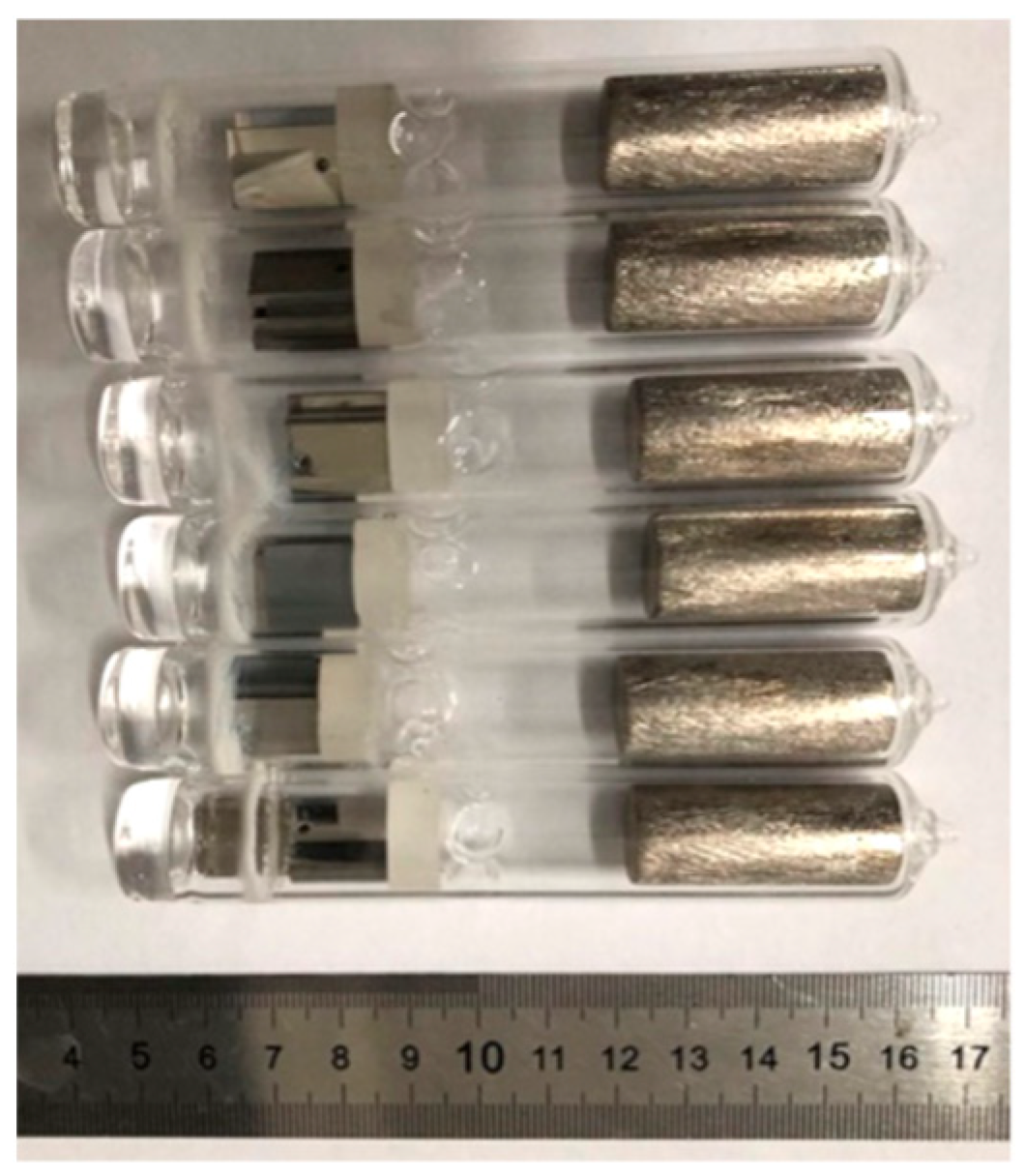
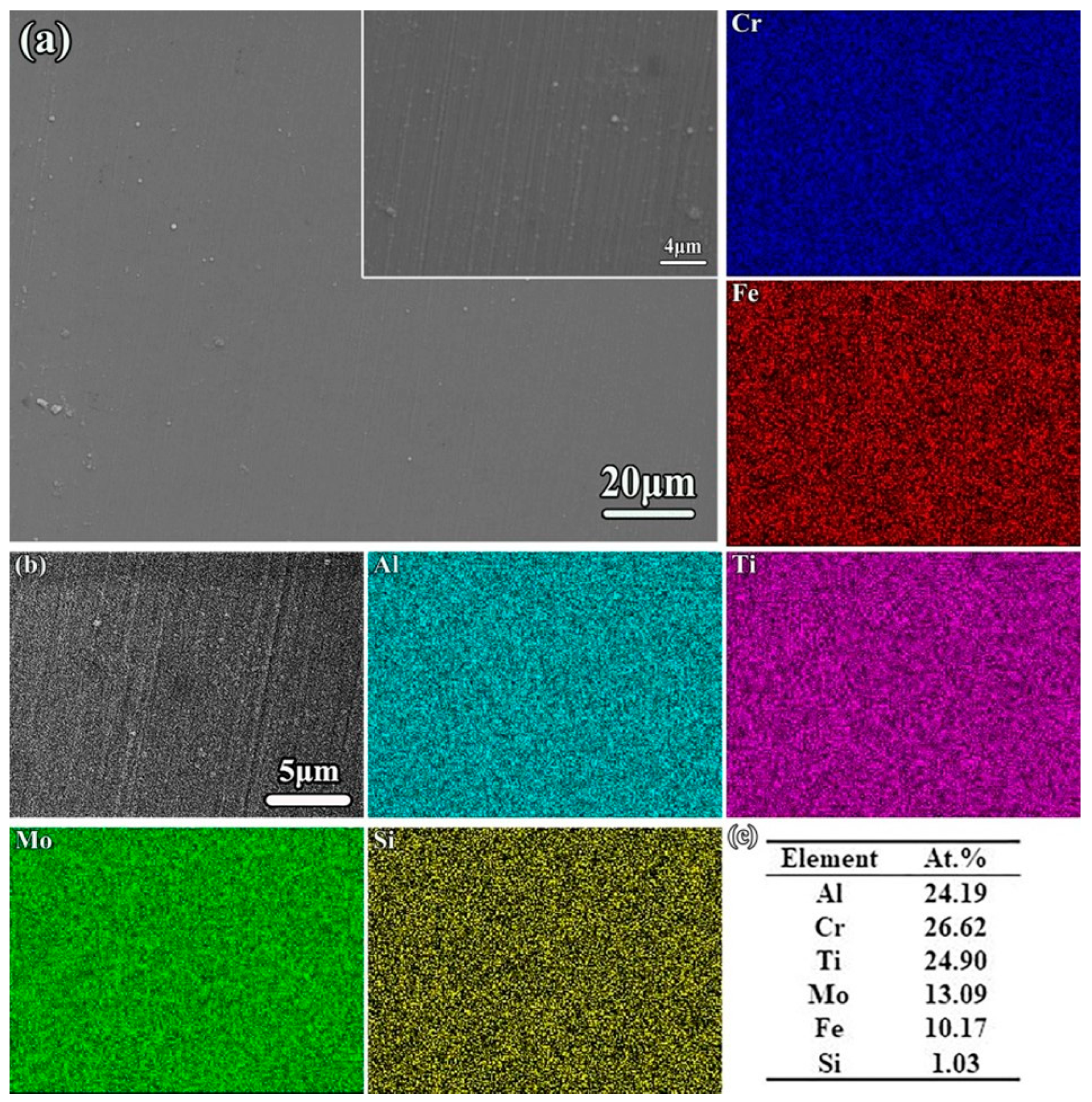
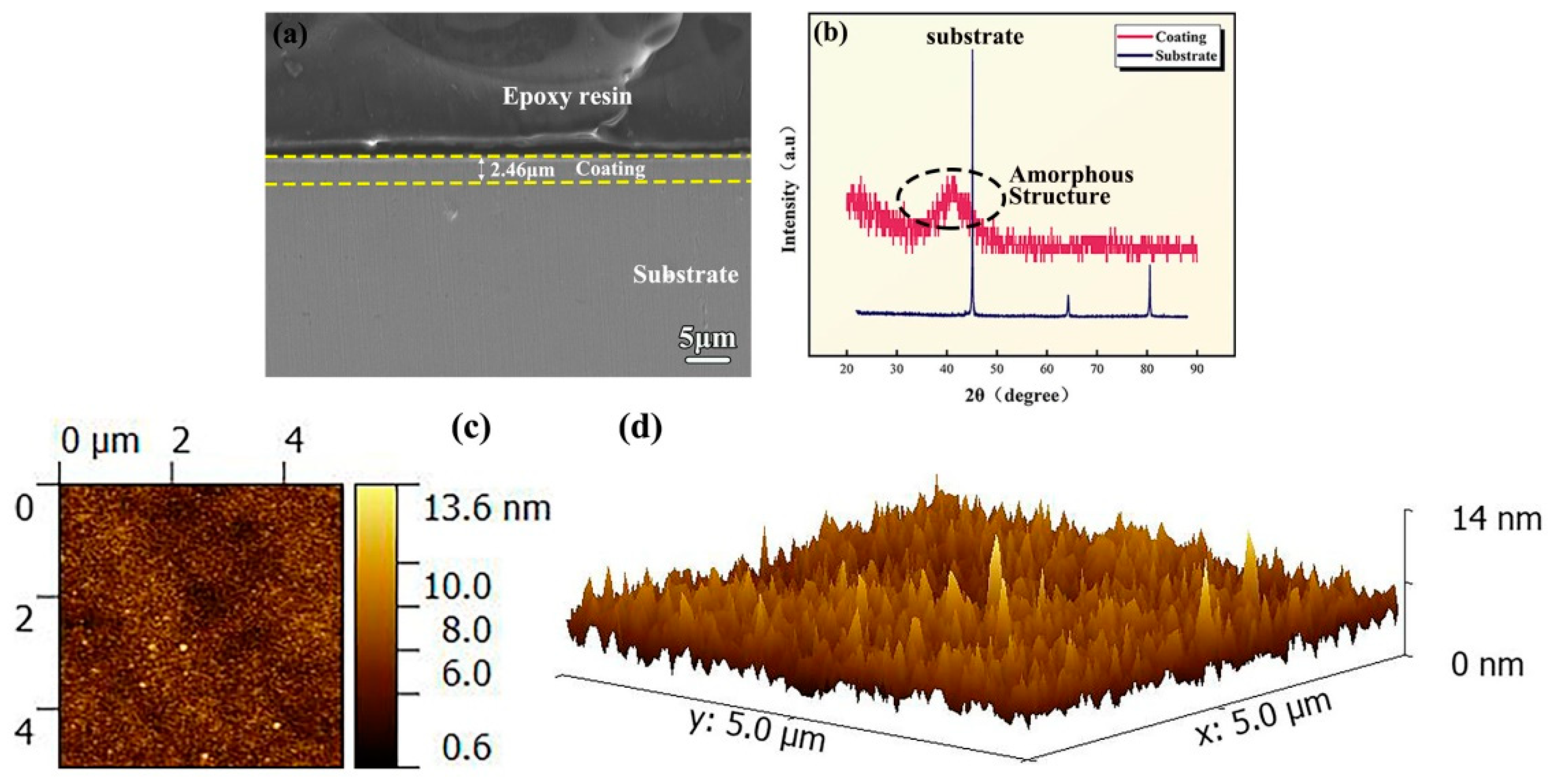


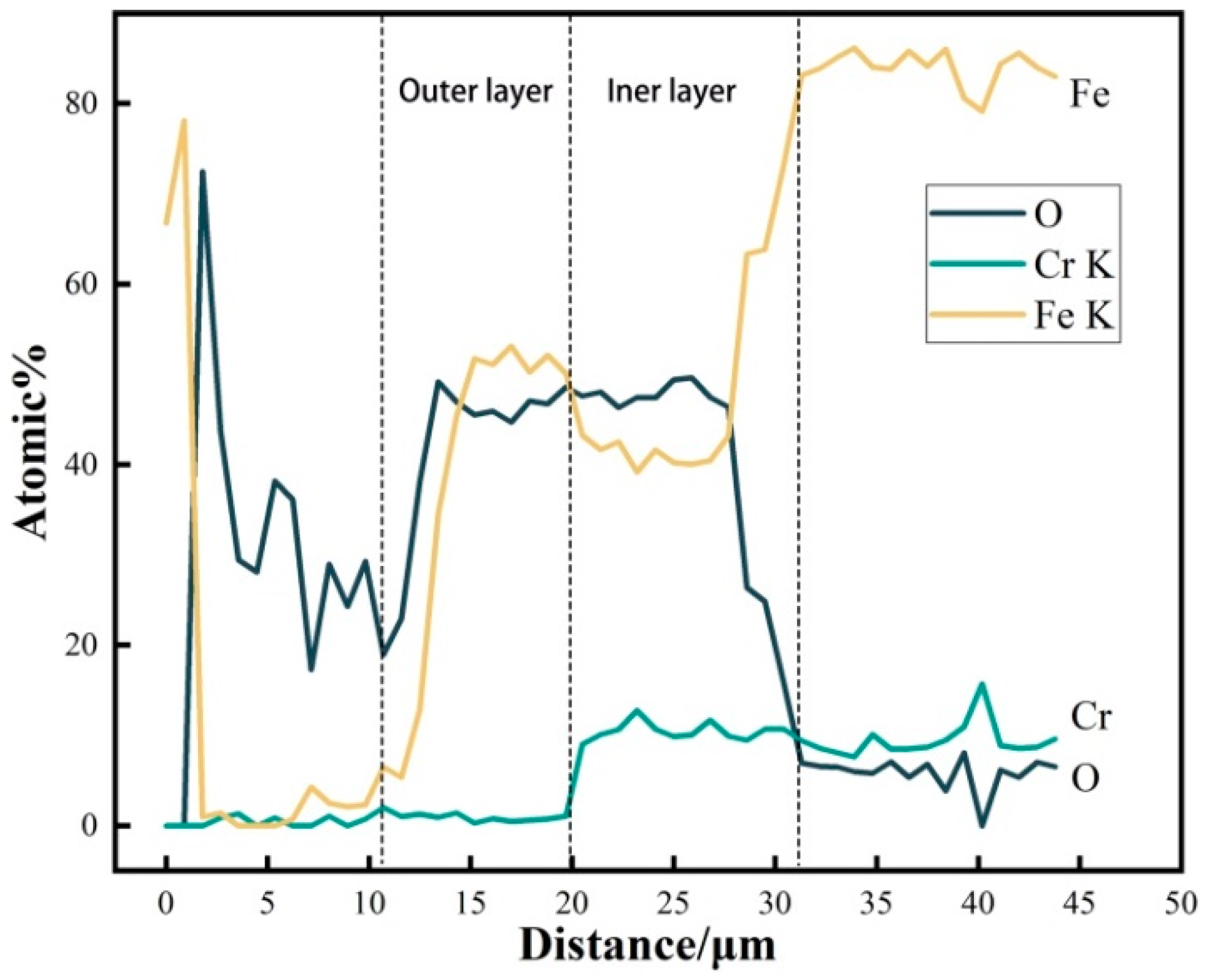
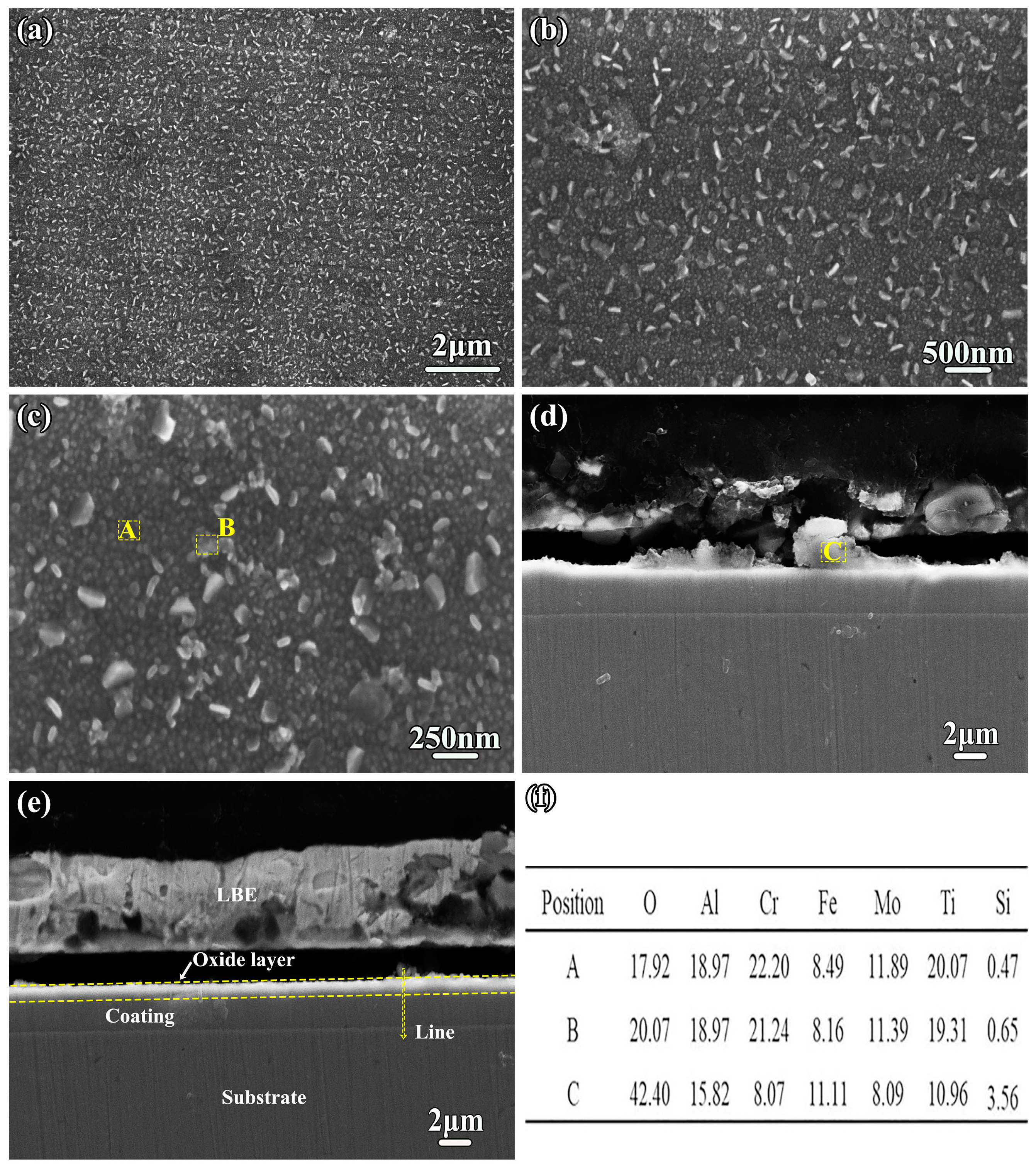

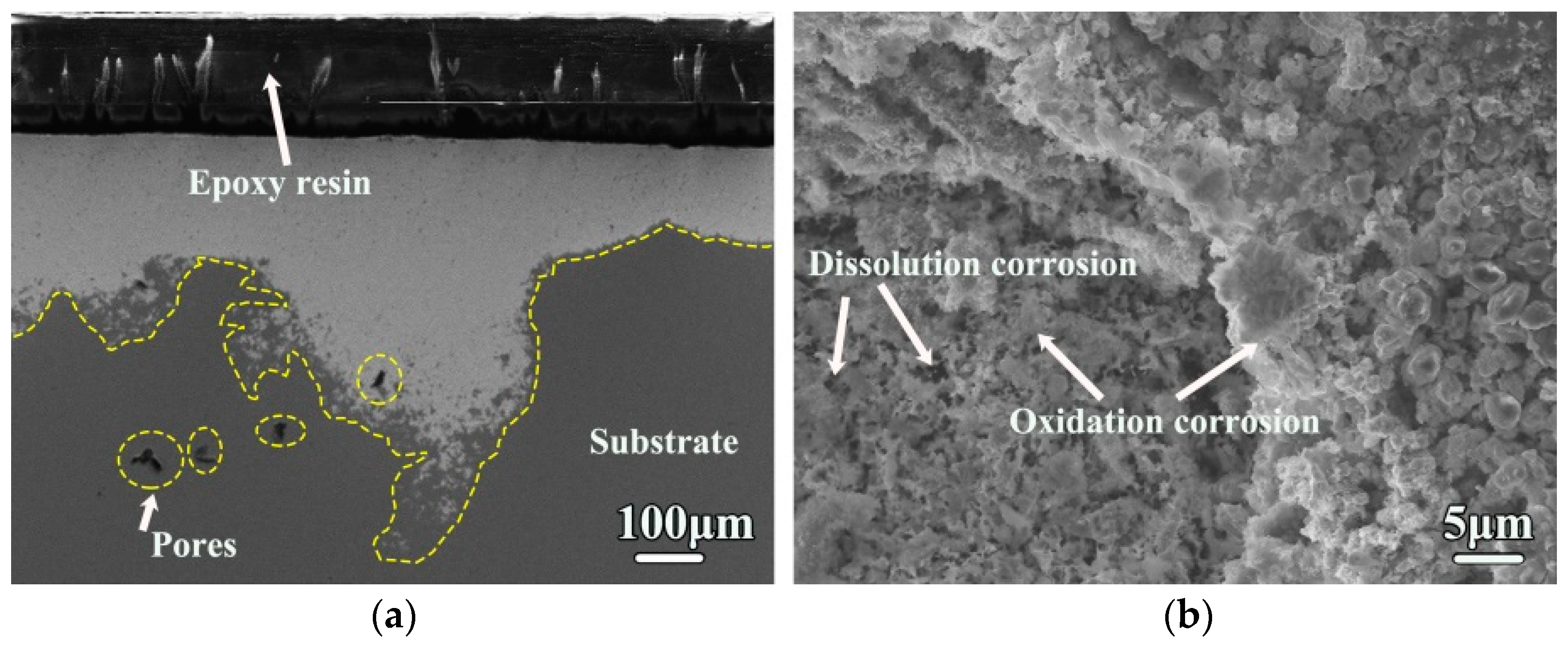
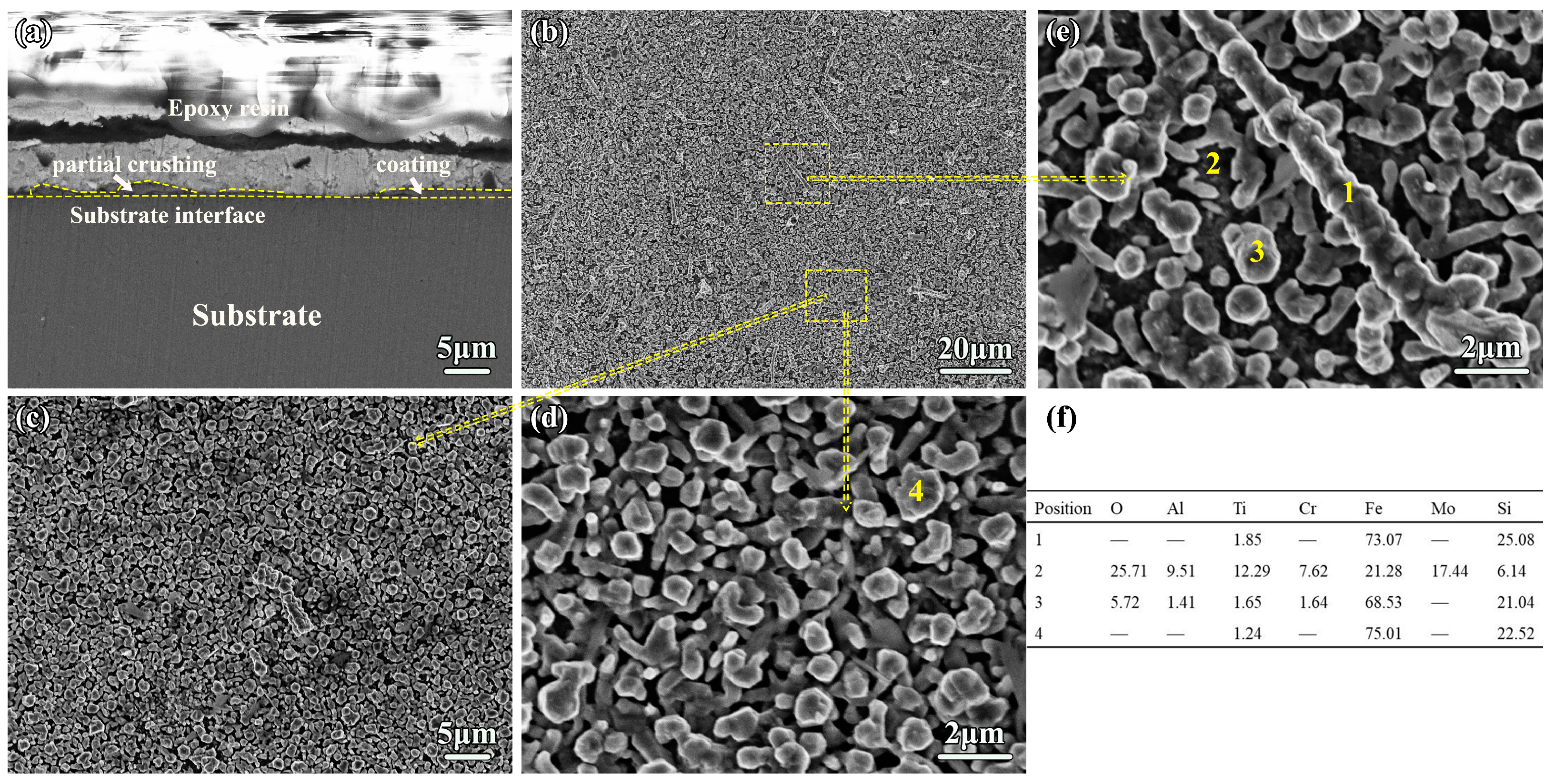
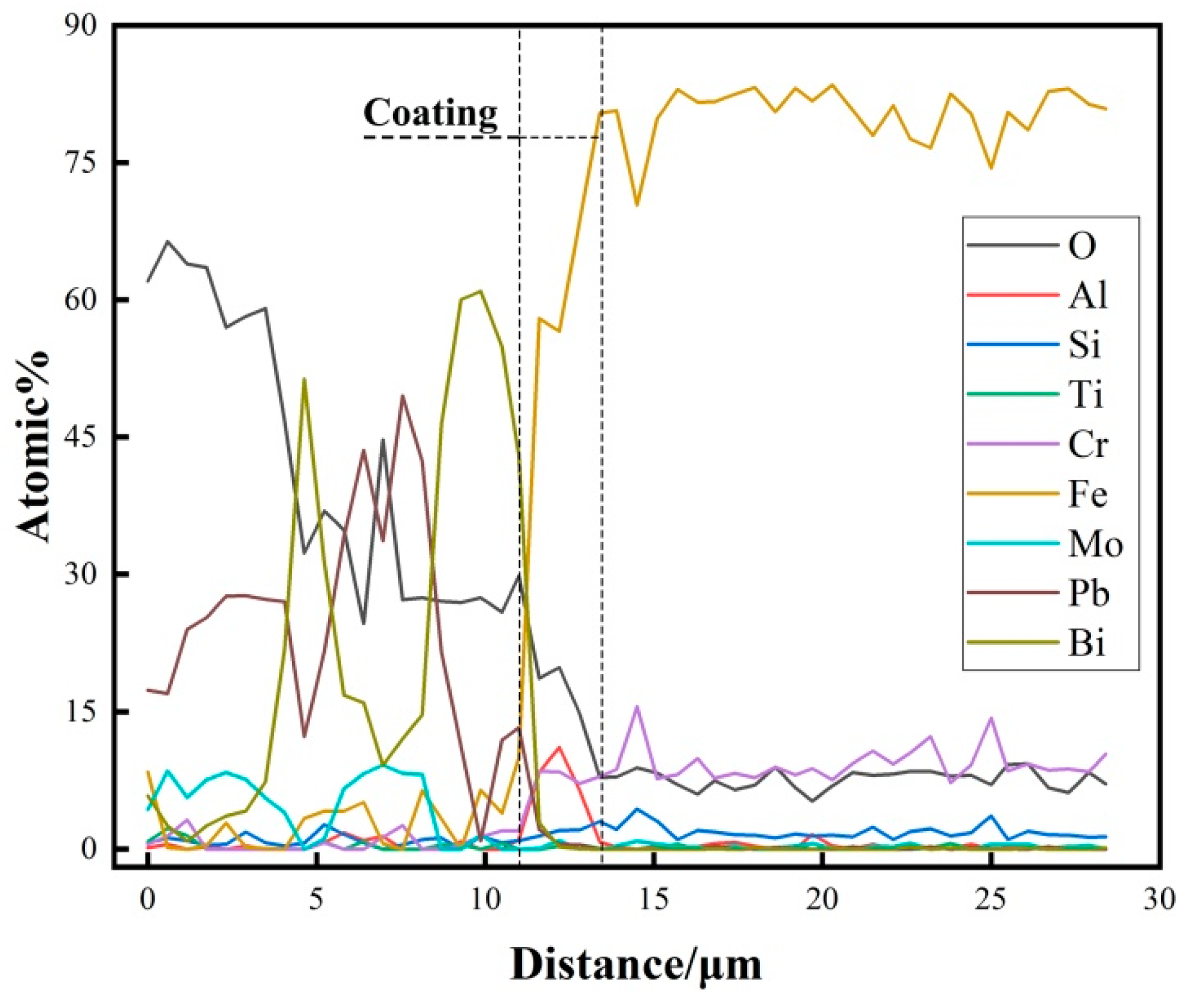
Disclaimer/Publisher’s Note: The statements, opinions and data contained in all publications are solely those of the individual author(s) and contributor(s) and not of MDPI and/or the editor(s). MDPI and/or the editor(s) disclaim responsibility for any injury to people or property resulting from any ideas, methods, instructions or products referred to in the content. |
© 2023 by the authors. Licensee MDPI, Basel, Switzerland. This article is an open access article distributed under the terms and conditions of the Creative Commons Attribution (CC BY) license (https://creativecommons.org/licenses/by/4.0/).
Share and Cite
Zhang, L.; Shi, Y.; Ye, Q.; Yang, B. Enhanced Corrosion−Resistance of AlTiCrFeMoSi High−Entropy Alloy Coating by Magnetron Sputtering. Coatings 2023, 13, 332. https://doi.org/10.3390/coatings13020332
Zhang L, Shi Y, Ye Q, Yang B. Enhanced Corrosion−Resistance of AlTiCrFeMoSi High−Entropy Alloy Coating by Magnetron Sputtering. Coatings. 2023; 13(2):332. https://doi.org/10.3390/coatings13020332
Chicago/Turabian StyleZhang, Li, Yunzhu Shi, Qilu Ye, and Bin Yang. 2023. "Enhanced Corrosion−Resistance of AlTiCrFeMoSi High−Entropy Alloy Coating by Magnetron Sputtering" Coatings 13, no. 2: 332. https://doi.org/10.3390/coatings13020332
APA StyleZhang, L., Shi, Y., Ye, Q., & Yang, B. (2023). Enhanced Corrosion−Resistance of AlTiCrFeMoSi High−Entropy Alloy Coating by Magnetron Sputtering. Coatings, 13(2), 332. https://doi.org/10.3390/coatings13020332




